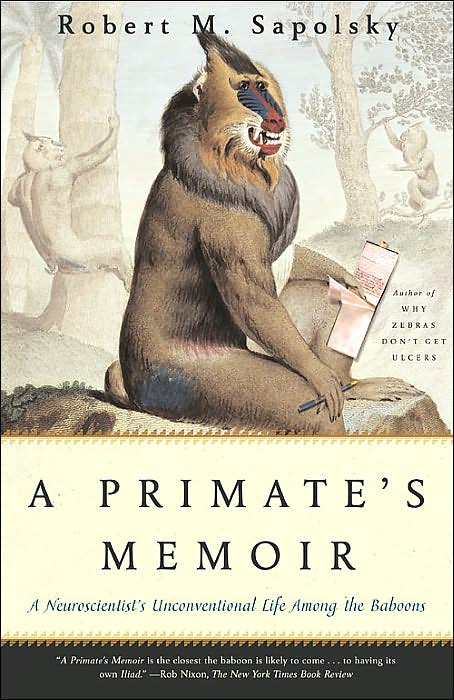Sapolsky’s A Primate’s Memoir is non-fiction, but it’s one of the most engaging things ever written. It’s another one of those books like Backroom Boys that you have no idea you want to read, but that you will love to pieces. Robert Sapolsky is a neuroscientist and primate researcher. In this book, he writes about his life and the lives of a tribe of baboons in Africa. He doesn’t lose the distinction between people and animals at all, but he writes about them in the same way, and not at all in the way people usually write about animals, or about people for that matter.
The only way I can describe the book is by quoting it, so here’s the first paragraph:
I joined the baboon troop during my twenty-first year. I had never planned to become a savannah baboon when I grew up, instead I had always assumed I would become a mountain gorilla. As a child in New York I had endlessly begged and cajoled my mother into taking me to the Museum of Natural History, where I would spend hours looking at the African dioramas, wishing to live in one. Racing effortlessly across the grasslands as a zebra certainly had its appeal, and on some occasions I could conceive of overcoming my childhood endomorphism and would aspire to giraffehood. During one period I became enthused with the collectivist utopian rants of my elderly communist relatives and decided that I would someday grow up to be a social insect. A worker ant, of course. I made the miscalculation of putting this scheme into an elementary school writing assignment about my plans for life, resulting in a worried letter from the teacher to my mother.
The whole book is like this, only better. He goes to Africa and observes baboons, he advances in his tribe as a scientist, he becomes friends with Kenyans. It’s a series of anecdotes, many of them funny and some of them terrible, all true, and surprisingly fascinating.
There’s a kind of earnestness about most writing of this kind which Sapolsky avoids. There’s a contrary kind of patronizing jocularity which I don’t think he’d recognise if it came up to him playing the bagpipes. He writes about baboons, and gorillas, and people, and for that matter hyenas and elephants, as if they’re all part of a spectrum of interest and intelligence. He talks about his naivety being taken in by scams and his desperation when his professor doesn’t send funds for months on end in the same tone as he talks about the baboon interactions. He sees getting his Ph.D. as the same kind of thing as the way the baboons advance in their hierarchy. He observes himself and everything around him with a wry intelligence. He’s always serious, but he’s also often hilarious.
I want to quote you another bit. There’s a story about his friend who studies hyenas being invited to a carnivore behavioural conference, funded by the U.S. military, who behave very oddly and tell various stories (some of which might be true) about why they are suddenly interested in carnivore behaviour. It ends:
Obvious possibilities as to the true story of what went on:
a) The carnivore biologists are just saying they never heard from Colonel Chuck again and are actually in cahoots with him up to their ears, sworn to secrecy.
b) The whole meeting was an exercise for Colonel Chuck and his pals in order to learn how to bribe, bully, cajole, and manipulate scientists. The carnivore biologists were just for practice, and they’re now pulling this off on rocket scientists.
c) Colonel Chuck and his army pals were actually herbivores in disguise, trying to gain information about carnivore hunting strategies.
This is a lovely lovely book and a joy to read—it’s also insightful about both baboon and scientist behaviour and has some interesting snippets about the recent history of Africa and wildlife management in Kenya. It would also make a great present for somebody who likes to read and has already read everything you’d normally give them.
Jo Walton is a science fiction and fantasy writer. She’s published eight novels, most recently Half a Crown and Lifelode, and two poetry collections. She reads a lot, and blogs about it here regularly. She comes from Wales but lives in Montreal where the food and books are more varied.










